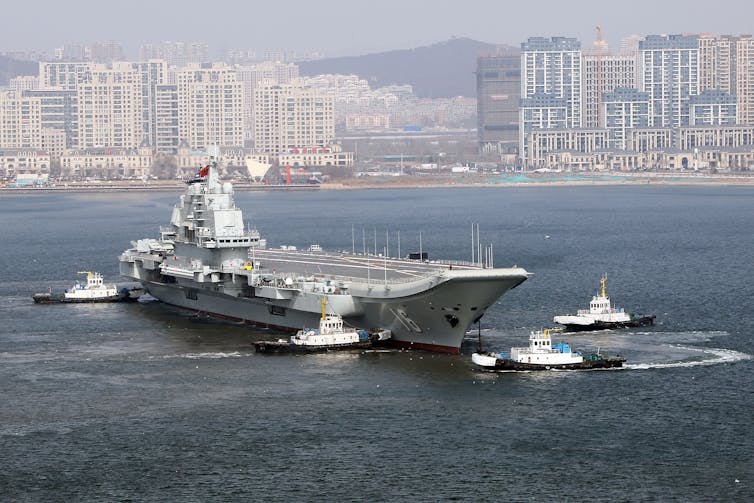US leaders view China as a ‘pacing threat’ − has Washington enough stamina to last the race?
The term refers to a power whose military capabilities are approaching that of the dominant power. But for the US, seeing China this way comes with big risks.

When Donald Trump meets with Xi Jinping on Oct. 30, 2025, he won’t just be chatting with any run-of-the-mill leader of a rival nation. Rather, he will be sitting down the with the chief representative of the United States’ “pacing threat.”
In the Pentagon’s lexicon, China has increasingly been presented as a “pacing challenge” or “pacing threat” − that is, a great-power rival against which a nation measures its strength, shapes its strategy and directs its resources across every domain of national power.
The phrase and concept has risen in military and academic circles since the turn of the 21st century. Its use in Washington to describe China dates to at least 2020, when Trump’s then–Secretary of Defense Mark Esper used it in a speech in Honolulu.
But what does it mean? For a country to be seen as a pacing threat, it must be a rising yet already near-peer whose capabilities and ambitions directly challenge the dominant country’s global position. A pacing threat doesn’t merely aspire to catch up; it sets the tempo of competition.
Esper’s successor in the Biden administration, Lloyd J. Austin III, continued to call China a “pacing threat,” explaining: “It means that China is the only country that can pose a systemic challenge to the United States in the sense of challenging us economically, technologically, politically and militarily.”
Use of “pacing threat/challenge” has grown since 2009 (Ngram)
The significance goes beyond rhetoric. By defining China in these terms, Washington reorients its entire defense establishment around a new strategic benchmark. The U.S.’s defense planning, industrial policy and global posture now revolve around a single question − how to keep up with and, if necessary, outpace Beijing.
When the United States government signals to its military leaders and industrial partners that a specific country is a “pacing threat,” it is giving them a yardstick by which to judge every dollar spent, every sailor or pilot assigned and every hour of training and preparation.
Pacing threats, increasing risks
The risk of focusing so intently on one foe is, of course, that there is more than one potential adversary out there. And the concept of a pacing challenge shouldn’t imply that China is Washington’s only competitor or potential enemy.
Other rivals remain in the mix, including Russia, Iran, North Korea and a range of smaller militant groups, that could cause major problems for Washington with or without China’s involvement.
The danger for the U.S. is that in designating China its only pacing threat, it could leave blind spots elsewhere. And the objective for a U.S. leader is not simply to be ready for a potential war with China but to be ready for the next crisis wherever it may emerge.
This goal is complicated by a second risk: the urge to plan for the future at the expense of the present. It is one thing for the U.S. Navy to build a fleet and the Air Force to design a missile for 2035 to ensure that it “outpaces” Chinese innovation. But it is another to have the capability to deter or address, if necessary, a crisis or conflict in 2025.
Developing a long-term force to match or surpass China is an important objective to U.S. political and military leaders, but not at the expense of current capabilities.
If the United States is intent on remaining the world’s predominant economic, diplomatic and military force, then it must focus on both – but that is easier said than done.
Is China already ahead?
There are some who believe that America’s pacing threat has already outpaced its rival.
The United States already lags behind China in the scale and output of its defense-industrial base – particularly in the quantity of ships, missiles and other military hardware it can produce and field at speed.
China is building warships at a rate unseen in the U.S. for decades. And it has an industrial ecosystem that can deliver on new programs and scale up in a crisis.
By contrast, American factories face labor shortages, a lack of modern shipyards and glacial acquisition timelines.
If the U.S. is intent on fielding better military assets in the future, it needs them to upscale at a speed that can deter China. In other words, America’s deterrence to any pacing threat needs to start at the factory gate.
A contest of speed, not size
Facing China as a pacing threat will start with an honest U.S. accounting of the type of competition in which it is engaged. This is not merely a rivalry of fleets or firepower but a contest of tempo − who can innovate faster, build smarter and field more flexibly to shape a world in motion.

If the U.S. is to outpace China, it will likely need to reconnect its economic and industrial base to its defense posture and regenerate the productive capacity that made America the world’s arsenal.
But that task is far harder for democracies, where political cycles, fiscal constraints and public skepticism about militarization often slow the mobilization of national power.
Complicating the matter is the fact that the next great arsenal will be defined not just in steel but in data, design and decision. Here, too, China at present appears to be gaining an upper hand. A September report by the Washington-based Information Technology and Innovation Foundation assessed that China was now “dramatically outperforming the United States in the vast majority of critical technological fields.”
The U.S. will not stay ahead of its pacing threat by meeting China ship for ship or system for system. The real edge is in responsiveness − the ability to outthink, outproduce and outmaneuver its competitor.
This article is part of a series explaining foreign policy terms commonly used but rarely explained.
Andrew Latham does not work for, consult, own shares in or receive funding from any company or organization that would benefit from this article, and has disclosed no relevant affiliations beyond their academic appointment.
Read These Next
Black-market oil buyers will push Venezuela for bigger discounts following US seizure – starving Mad
Venezuela relies on the black-market oil trade for a large chunk of its revenue. US enforcement actions…
As a former federal judge, I’m concerned by a year of challenges to the US justice system
A university president who’s a former federal judge looks at the rule of law and the Trump administration’s…
AI’s errors may be impossible to eliminate – what that means for its use in health care
Many health symptoms can be caused by multiple illnesses – if AI can’t tell the difference between…





